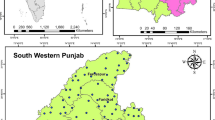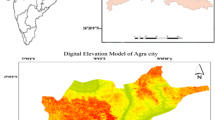Abstract
Urbanization and population growth resulted in the depletion of groundwater (GW) in the Rajasthan. According to Central Ground Water Board (2019), groundwater level (GWL) decline was observed in eastern part of the Rajasthan. The Jaipur division is situated in the eastern part of the Rajasthan. For effective GW resource usage and planning of GW management strategies, trend analyses in GWLs, rainfall and mean temperature (TEMP) of all blocks in districts of the Jaipur division, Rajasthan is carried out for four seasons over the period of 1994 to 2018. For trend analyses autocorrelation plot, Mann-Kendall (MK), MK with block bootstrapping test, sequential MK test, Sen’s slope test, innovative trend analysis plot and smoothing curve are used. Prioritization of all blocks in the districts of the Jaipur division is also carried out on the basis of trend analyses of GWLs. Form the current study, it is found that, there is significant decrease in GW in most of the blocks of the Jaipur division corresponding to all four seasons. Also, most of the blocks in the Jaipur division have shown increase in mean TEMP and decrease in rainfall corresponding to all four seasons. In addition, stages of GW extraction percentages are found to be more than 100% in most of the blocks in the Jaipur division, Rajasthan. From the aforesaid results, it can be concluded that, GW is decreasing due to increasing TEMP, decreasing rainfall and over exploitation of GW in most of the blocks in the Jaipur division, Rajasthan.
Similar content being viewed by others
References
Adarsh, S. and Reddy, M.J. (2015) Trend Analysis of Rainfall in Four Meteorological Subdivisions of Southern India Using Nonparametric Methods and Discrete Wavelet Transforms. Internat. Jour. Climatol., v.35, pp.1107–1124.
Allen, D.M., Stahl, K., Whitfield, P.H. and Moore, R.D. (2014) Trends in Groundwater Levels in British Columbia. Canadian Water Resour. Jour., v.39(1), pp.15–31.
Bui, D.D., Kawamura, A., Tong, T.N., Amaguchi, H., and Nakagawa, N. (2012) Spatio-Temporal Analysis of Recent Groundwater-Level Trends in the Red River Delta, Vietnam. Hydrogeol. Jour., v.20(8), pp.1635–1650.
Central Ground Water Board (2017) Groundwater brochure Dausa district, Rajasthan. Western Region Jaipur, Ministry of Water Resources, River Development and Ganga Rejuvenation, Government of India.
Central Ground Water Board (2008) Groundwater brochure Jhunjhunu district, Rajasthan. Western Region Jaipur, Ministry of Water Resource, Government of India.
Central Ground Water Board (2013a) Groundwater information Alwar district, Rajasthan. Western Region Jaipur, Ministry of Water Resources, Government of India.
Central Ground Water Board (2013b) Groundwater information Jaipur district, Rajasthan. Western Region Jaipur, Ministry of Water Resources, Government of India.
Central Ground Water Board (2013c) Ground water scenario Sikar district, Rajasthan. Western Region Jaipur, Ministry of Water Resources, Government of India.
Central Ground Water Board (2019) Ground water year book 2018–2019, Rajasthan. Western Region Jaipur, Ministry of Jal Shakti, Department of Water Resources, Ganga Rejuvenation.
Central Ground Water Board, Western Region, 6-A, Jhalana Doongri, Jaipur 302004, Rajasthan.
Chinnasamy, P., Maheshwari, B. and Prathapar, S. (2015) Understanding Groundwater Storage Changes and Recharge in Rajasthan, India Through Remote Sensing. Water, v.7(10), pp.5547–5565.
Gerstengarbe, F.W. and Werner, P.C. (1999) Estimation of the Beginning and End of Recurrent Events Within A Climate Regime. Climate Res., v. 11(2), pp.97–107.
Gibrilla, A., Anornu, G. and Adomako, D. (2018) Trend Analysis and ARIMA Modelling of Recent Groundwater Levels in the White Volta River Basin of Ghana. Groundwater for Sustainable Development, v.6, pp.150–163.
Kawamura, A., Bui, D.D., Tong, T.N., Amaguchi, H. and Nakagawa, N. (2011) Trend Detection in Groundwater Levels of Holocene Unconfined Aquifer in Hanoi, Vietnam, by Non-Parametric Approaches. World Environmental and Water Resources Congress, pp.914–923.
Kaushik, N. (2018) Impact of Climate Change on Water Resources in Arid and Semi Arid Region of Rajasthan. Jour. Water and Land use Management, v. 16(2), pp.53–62.
Khaliq, M.N., Ouarda, T.B., Gachon, P., Sushama, L. and St-Hilaire, A. (2009) Identification of Hydrological Trends in the Presence of Serial and Cross Correlations: A Review of Selected Methods and Their Application to Annual Flow Regimes of Canadian Rivers. Jour. Hydrol., v.368(1–4), pp.117–130.
Kumar, S., Dhyani, B.L. and Singh, R.J. (2013) Depleting Groundwater Resources of Rajasthan State and its Implications.Popular Kheti, v.1(3). https://www.popularkheti.info
Kundzewicz, Z.W. and Robson, A.J. (2000) Detecting Trend and Other Changes in Hydrological Data. World Climate Programme Data and Monitoring, WMO/TD-No.1013, Geneva.
Mujumdar, P.P. (2012) Lecture Notes 11 and 12, Stochastic Hydrology, Department of Civil Engineering, Indian Institute of Science (IISc), Banglore. https://nptel.ac.in/courses/105/108/105108079/. Accessed 29 May 2020.
Panda, D.K., Mishra, A. and Kumar, A. (2012) Quantification of Trends in Groundwater Levels of Gujarat in Western India. Hydrological Sci. Jour., v.57(7), pp.1325–1336.
Patle, G.T., Singh, D.K., Sarangi, A., Rai, A., Khanna, M. and Sahoo, R.N. (2015) Time Series Analysis of Groundwater Levels and Projection of Future Trend. Jour. Geol. Soc. India, v.85(2), pp.232–242.
Ribeiro, L., Kretschmer, N., Nascimento, J., Buxo, A., Rotting, T., Soto, G., Senoret, M., Oyarzun, J., Maturana, H. and Oyarzun, R. (2015) Evaluating Piezometric Trends Using the Mann-Kendall Test on the Alluvial Aquifers of the Elqui River Basin, Chile. Hydrological Sci. Jour., v.60(10), pp.1840–1852.
Rivard, C., Vigneault, H., Piggott, A.R., Larocque, M. and Anctil, F. (2009) Groundwater Recharge Trends in Canada. Canadian Jour. Earth Sci., v.46(11), pp.841–854.
Saikia, P. and Chetry, N. (2020) Study of Fluctuations in the Groundwater Level in Rajasthan: A Spatio-Temporal Approach. Internat. Jour. Engg. Res. Tech., v.9(7), pp.1188–1192, https://www.ijert.org
Sen, Z. (2017) Innovative Trend Methodologies in Science and Engineering, Springer International Publishing AG 2017, pp.175–226. Available at: DOI https://doi.org/10.1007/978-3-319-52338-5_5
Shalini, T.A., Pandey, A.C. and Nathawat, M.S. (2012) Groundwater Level and Rainfall Variability Trend Analysis Using GIS in Parts of Jharkhand State (India) for Sustainable Management of Water Resources. Internat. Res. Jour. Environ. Sci., v.1(4), pp.24–31.
Sharma, A., Sharma, D., Panda, S.K., Dubey, S.K. and Pradhan, R.K. (2018) Investigation of Temperature and its Indices Under Climate Change Scenarios Over Different Regions of Rajasthan State in India. Global and Planetary Change, v.161, pp.82–96.
Singh, A., Sharma, C.S., Jeyaseelan, A.T. and Chowdary, V.M. (2015) Spatio-Temporal Analysis of Groundwater Resources in Jalandhar District of Punjab State, India. Sustainable Water Resources Management, v.1(3), pp.293–304.
Singh, O., Kasana, A., Singh, K.P. and Sarangi, A. (2019) Analysis of Drivers of Trends in Groundwater Levels Under Rice-Wheat Ecosystem in Haryana, India. Natural Resour. Res., pp.1–26.
Singh, R.P., Amit, D. and Ajay, K. (2014) Spatiotemporal Characteristics of Ground Water Level Fluctuation in Jaipur Urban Area Rajasthan, India. Global Journal of Research and Review, https://www.gjrr.org
Sishodia, R.P., Shukla, S., Graham, W.D., Wani, S.P. and Garg, K.K. (2016) Bi-decadal Groundwater Level Trends in A Semi-Arid South Indian Region: Declines, Causes and Management. Jour. Hydrology: Regional Studies, v.8, pp.43–58.
Sonali, P. and Nagesh Kumar, D. (2013) Review of Trend Detection Methods and their Application to Detect Temperature Changes in India. Jour. Hydrol., v.476, pp.212–227.
Tabari, H., Nikbakht, J. and Some’e, B.S. (2012) Investigation of Groundwater Level Fluctuations in the North of Iran. Environ. Earth Sci., v.66(1), pp.231–243.
Vahid, G (2013) Modelling of Ground Water Level Using Statistical Method and GIS. A Case Study: Amol-Babol Plain, Iran. Internat. Jour. Water Resour. Environ. Sci., v.2(3), pp.53–59.
Vousoughi, F.D., Dinpashoh, Y., Aalami, M.T. and Jhajharia, D. (2013) Trend Analysis of Groundwater Using Non-Parametric Methods (Case Study: Ardabil Plain). Stochastic Environmental Research and Risk Assessment, v.27(2), pp.547–559.
Zafor, M., Alam, M., Bin, J., Rahman, M. and Amin, M.N. (2017) The Analysis of Groundwater Table Variations in Sylhet Region, Bangladesh. Environ. Engg. Res., v.22(4), pp.369–376.
Acknowledgement
The authors are grateful to the Central Ground Water Board, India, Climate Engine Website and Climate Change Knowledge Portal for making required data available, which is utilized in this study.
Author information
Authors and Affiliations
Corresponding author
Rights and permissions
About this article
Cite this article
Phulpagar, S.R., Kale, G.D. Prioritization of All Blocks in Districts of the Jaipur Division with Investigation of Factors Affecting Significant Trends in GWLs. J Geol Soc India 97, 1454–1464 (2021). https://doi.org/10.1007/s12594-021-1886-9
Received:
Accepted:
Published:
Issue Date:
DOI: https://doi.org/10.1007/s12594-021-1886-9




